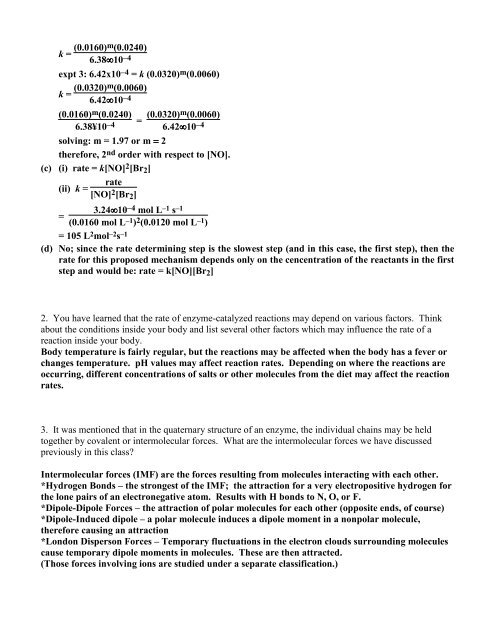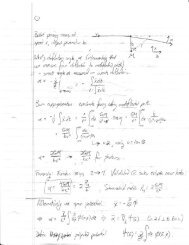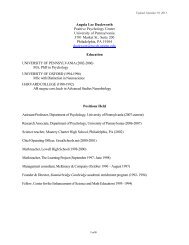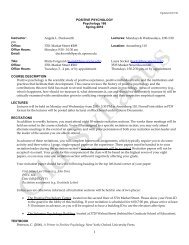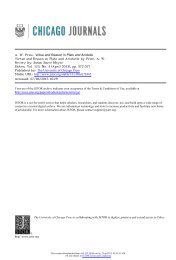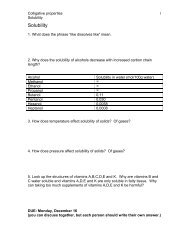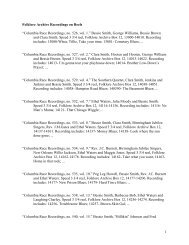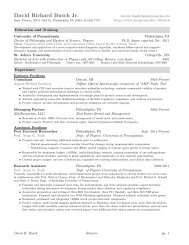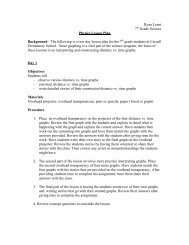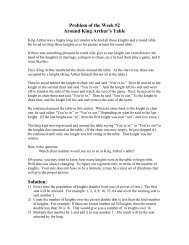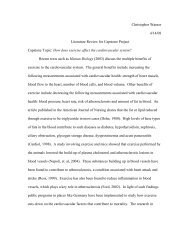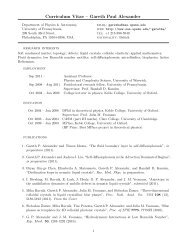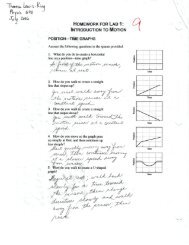Dusty Carroll Lesson Plan 4: Getting to know Lactase Background ...
Dusty Carroll Lesson Plan 4: Getting to know Lactase Background ...
Dusty Carroll Lesson Plan 4: Getting to know Lactase Background ...
You also want an ePaper? Increase the reach of your titles
YUMPU automatically turns print PDFs into web optimized ePapers that Google loves.
k = (0.0160)m (0.0240)<br />
6.38∞10 –4<br />
expt 3: 6.42x10 –4 = k (0.0320) m(0.0060)<br />
k = (0.0320)m (0.0060)<br />
6.42∞10 –4<br />
(0.0160) m (0.0240)<br />
6.38¥10 –4 = (0.0320)m (0.0060)<br />
6.42∞10 –4<br />
solving: m = 1.97 or m = = 2<br />
therefore, 2nd order with respect <strong>to</strong> [NO].<br />
(c) (i) rate = k[NO] 2[Br2]<br />
rate<br />
(ii) k =<br />
[NO] 2 [Br2]<br />
3.24∞10<br />
=<br />
–4 mol L –1 s –1<br />
(0.0160 mol L –1 ) 2 (0.0120 mol L –1 )<br />
= 105 L2mol –2s –1<br />
(d) No; since the rate determining step is the slowest step (and in this case, the first step), then the<br />
rate for this proposed mechanism depends only on the cencentration of the reactants in the first<br />
step and would be: rate = k[NO][Br2]<br />
2. You have learned that the rate of enzyme-catalyzed reactions may depend on various fac<strong>to</strong>rs. Think<br />
about the conditions inside your body and list several other fac<strong>to</strong>rs which may influence the rate of a<br />
reaction inside your body.<br />
Body temperature is fairly regular, but the reactions may be affected when the body has a fever or<br />
changes temperature. pH values may affect reaction rates. Depending on where the reactions are<br />
occurring, different concentrations of salts or other molecules from the diet may affect the reaction<br />
rates.<br />
3. It was mentioned that in the quaternary structure of an enzyme, the individual chains may be held<br />
<strong>to</strong>gether by covalent or intermolecular forces. What are the intermolecular forces we have discussed<br />
previously in this class?<br />
Intermolecular forces (IMF) are the forces resulting from molecules interacting with each other.<br />
*Hydrogen Bonds – the strongest of the IMF; the attraction for a very electropositive hydrogen for<br />
the lone pairs of an electronegative a<strong>to</strong>m. Results with H bonds <strong>to</strong> N, O, or F.<br />
*Dipole-Dipole Forces – the attraction of polar molecules for each other (opposite ends, of course)<br />
*Dipole-Induced dipole – a polar molecule induces a dipole moment in a nonpolar molecule,<br />
therefore causing an attraction<br />
*London Disperson Forces – Temporary fluctuations in the electron clouds surrounding molecules<br />
cause temporary dipole moments in molecules. These are then attracted.<br />
(Those forces involving ions are studied under a separate classification.)


